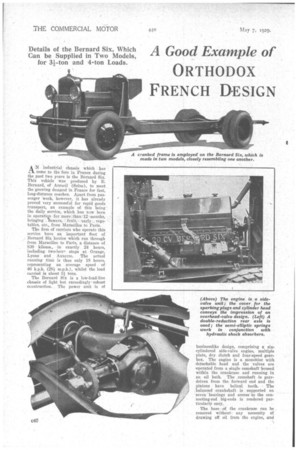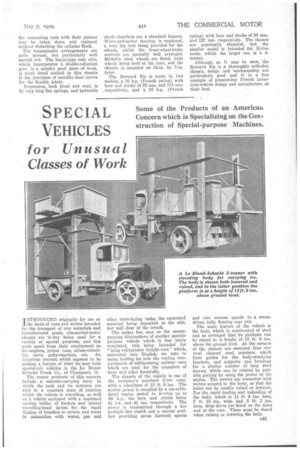A Good Example of ORTHODOX FRENCH DESIGN
Page 72

Page 73

If you've noticed an error in this article please click here to report it so we can fix it.
Details of the Bernard Six, Which Can be Supplied in Two Models, for 3i-ton and 4-ton Loads.
A N industrial chassis which has Z1 come to the fore in France during the past two years is the Bernard Six.•This vehicle was produced by E.
Bernard, of Arcueil (Seine), to meet the growing demand in France for fast, long-distance coaches. Apart from passenger work, however, it has already proved very successful for rapid goods transport, an example of this being' the daily service, which has nxcv been in operation for more than'12 months, bringing llowers, " fruit, early vegetables, ate., from Marseilles to Paris.
The firm of carriers who operate this service have an important fleet of Bernard Six lorries which run through from Marseilles to Paris, a distance of 830 kiloms., in exactly 24 hours, including two-bonstops at Orange, Lyons and Auxerre. The actual running time is thus only 18 hours, representing an average speed of 46 k.p.h. (28i m.p.h.), whilst the load carried is about 31 tons.
The Bernard Six is a low-load-line chassis a light but exceedingly•rohust construction. The power unit is of
businesslike design, comprising a sixcylindered side-valve engine, multiple plate, dry, clutch and four-speed gearbox. The engine is a monobloc with detachable head and the valves are operated from a single camshaft housed within the crankcase and running in an oil bath. The camshaft is geardriven from the forward end and the pinions have helical teeth. The balanced crankshaft is supported on seven liearingS and access to the connecting-rod big-ends is rendered particularly easy.
The base of the crankcase can be removed withoutany necessity of drawing off oil from the engine, and the connecting rods with their pistons may be taken down and replaced without disturbing the cylinder Clock.
The transmission arrangements are Quite normal, but particularly well carried out. The banjo-type rear axle, which incorporates a double-reduction gear, is a notably good piece of work. A small detail noticed in this chassis is the provision of metallic dust covers for the flexible joints.
Suspension, both front and rear, is by very long fiat springs, and hydraulic shock absorbers are a standard fitment. Worm-and-sector steering is employed, a very big lock being provided for the wheels, whilst the front-wheel-brake controls are specially well arranged. Michelin steel wheels are fitted, twin wheels being used at the rear, and the chassis is mounted on 34-in. by 7-in. tyres.
The Bernard Six is made in two models, a 16 h.p. (French rating) with bore and stroke of 82 mm. and 115 mm. respectively, and a 22 h.p. (French rating) with bore and stroke of 98 ram. and 127 ram. respectively. The chas.sis are practically identical, but the smaller model is intended for 3i-ton loads, whilst the larger one is a 4tanner.
Although, as it may be seen, the Bernard Six is a thoroughly orthodox chassis, design and workmanship are particularly good and it is a fine example of present-day French industrial-vehicle design and manufacture at their best.






























































































































